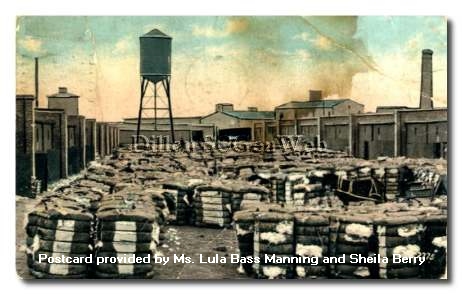Cotton in the Little Pee Dee Valley
by Victoria Proctor
For many years, cotton was king in Dillon County (Upper Marion), and in the
post-Revolutionary period, cotton became the dominant crop.
FROM COTTON SEED TO BALES (IN BRIEF)
 It takes about two hundred days to grow cotton to maturity. The
seed is planted about April, and the cotton is picked about September or October.
Cotton had to be picked by hand until the introduction of the mechanical cotton picker.
The McCormick-Deering mechanical picker delivered in 1948 to a farmer in Dillon County
was said to equal the work of 40-50 laborers picking cotton by hand.
It takes about two hundred days to grow cotton to maturity. The
seed is planted about April, and the cotton is picked about September or October.
Cotton had to be picked by hand until the introduction of the mechanical cotton picker.
The McCormick-Deering mechanical picker delivered in 1948 to a farmer in Dillon County
was said to equal the work of 40-50 laborers picking cotton by hand.
Once the cotton is picked, it is weighed, then spread out to be dried and sunned
prior to "ginning" (the process of separating cotton fibers from its seeds).
The invention of the mechanical cotton gin
by Eli Whitney in 1793 eased the process.

After ginning, the cotton lint, or fiber, is put into a press which
packs them together to form a bale.
Mr. Stokes tells us in his
History of Dillon County, published 1978:
[The rise in cotton production]" was greatly accelerated about 1798
by "Buck Swamp"
John BETHEA when he erected the first gin house in the county and a cotton
press. Oxen or mules were used to rotate the beam of the latter, compressing the
lint into bales. The gin disappeared long ago, but the stoutly-built press,
though unused for many years, is still in existence as a reminder of its former
usefulness."
Cotton bales weigh between 300 to 600 pounds, though standard American bales
weigh 500 pounds and are about 27" x 54" x 45" in size. The bale is wrapped around with jute
or cotton bagging and held together by six steel bands. Note the cotton bales in the 1914
postcard below.

Cotton Warehouse
Postcard mailed from Wilson, NC on 8 Dec 1914 and sent to Mr. Henry Berry, Jr. from Frances.
Original provided by Ms. Lula Bass Manning of Latta to Sheila Berry, who contributed a copy to the
Dillon County site.
Cotton that has passed through the gin and has been baled is classified
into standard grades. The most common of these grades is middling. There are four
grades above and four grades below middling cotton. Graded bales are then sent to warehouses
where it is stored prior to shipment to cotton (textile) mills where the cotton lint is turned into fabric.
Dillon County History and Genealogy
By Victoria Proctor. All rights reserved.


